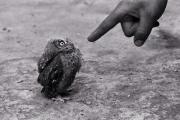Iím new to owning / utilizing steel targets. Iíve shot plenty of steel before, but they were all someone elseís targets and, thusly, someone elseís problem.
Recently, I purchased some TacStrike 1/4" steel target systems. I posted a few questions prior to purchasing them, which you can find here. I have fired up to 7.62x39 Wolf Brand ammo at them, and the targets have done little more than lose some paint: no tangible surface deformations whatsoever. But then I started shooting 55 grain 5.56, and I had a problem.
According to TacStrike, the maximum velocity of a rifle round could not be more than 3,200 feet per second to keep the target from being damaged. The ammo we were using was rated at 3,176 feet per second. Upon harnessing the full might of my nigh-on immesurable brillance, I said, "It's only 3,176 feet per second? That's like, 24 whole feet per second slower than the maximum!"
Naturally, this happened.
The surface of the plates are tangibly dimpled. That's bad, right? Is this side of the plate not safe to use now? Can I use the other side of the plate (there are a few pieces of chipped paint, but the surface is smooth, so far as I can tell)?
I have some 62 grain 5.56 NATO lying around. Can I expect the same results from that load, assuming a 16" barrel out of an AR-15 platform? What is the norm for people shooting steel with 5.56, in terms of round weight, velocity, steel hardness, et cetera?




 Reply With Quote
Reply With Quote


 For the OP: Yes, you can just turn the targets around to the non-dimpled side and go back to shooting. If you are going to want to shoot the dimpled side use it at a greater distance to reduce the chance of problematic backsplash.
For the OP: Yes, you can just turn the targets around to the non-dimpled side and go back to shooting. If you are going to want to shoot the dimpled side use it at a greater distance to reduce the chance of problematic backsplash.

